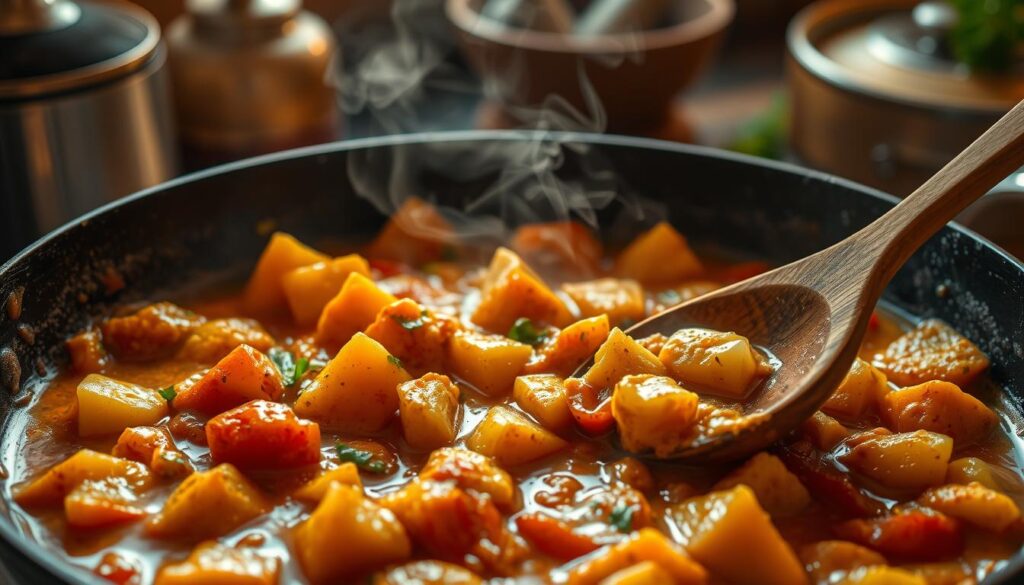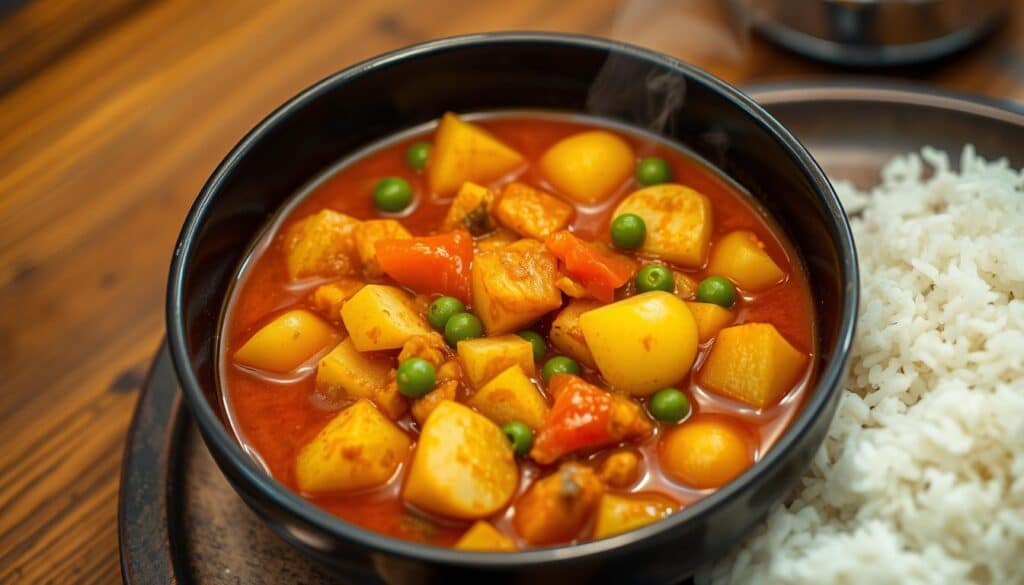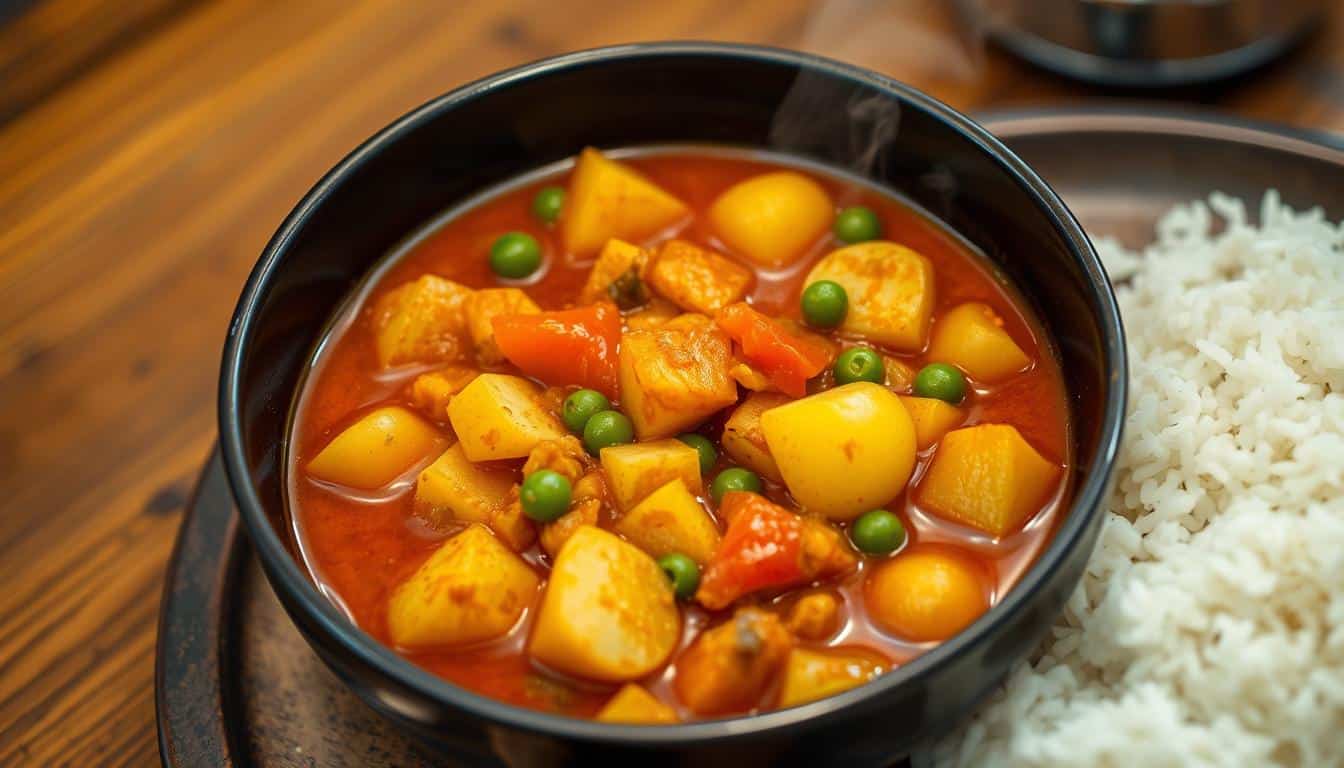There’s something truly special about a vibrant, one-pan mixed Indian vegetable curry. The moment the aroma of spices fills your kitchen, you know you’re in for a treat. This dish isn’t just a meal; it’s an experience that brings people together.
Thank you for reading this post, don't forget to subscribe!At its heart, this recipe is inspired by traditional home cooking, where fresh ingredients and pantry staples come together in perfect harmony. Whether you’re serving it with basmati rice, naan, or roti, it’s a versatile dish that adapts to your preferences. Plus, it’s naturally gluten-free and vegan-friendly, making it a great option for everyone.
I love how customizable this curry is. Want more veggies? Add them! Prefer a creamier texture? A splash of coconut milk works wonders. It’s all about creating a flavor profile that feels like home.
What really excites me about this recipe is how it balances simplicity with depth. From the sizzle of cumin seeds to the richness of fresh tomatoes, every step feels intentional. And let’s not forget the spices—turmeric, coriander, and a hint of chili powder come together to create a warm, inviting flavor that’s hard to resist.
So, whether you’re a curry lover or just exploring new flavors, this recipe is sure to delight. It’s more than just a meal; it’s a celebration of taste and tradition.

Key Takeaways
- A vibrant, one-pan mixed vegetable curry inspired by traditional home cooking.
- Uses fresh ingredients and pantry staples for a simple, healthy meal.
- Customizable with your choice of vegetables or proteins like tofu.
- Naturally gluten-free and vegan-friendly.
- Ready in about 30 minutes, perfect for a quick and delicious meal.
Introduction: Embracing the Spicy World of Vegetable Curry
My journey into the vibrant world of vegetable curry began with a simple realization: the way spices and fresh ingredients come together is nothing short of magical. This recipe beautifully marries a mix of colorful vegetables with robust spices, creating a dish that’s both nourishing and flavorful.
The foundation of a great curry lies in its ingredients. Garlic and tomatoes are essential, as they add depth and a touch of acidity. When sautéed with onions, they form a light, aromatic base that enhances the natural flavors of the vegetables. The key is to assemble these ingredients in just the right way to bring out their best qualities.
What I love most about this recipe is its balance. It’s spicy, but not overpowering, allowing the vibrant flavors of the vegetables to shine through. With a little time and the right technique, even someone new to cooking can create a delightful curry in just a few minutes. It’s the perfect blend of simplicity and flavor, making it a great fit for a busy lifestyle.
Indian Vegetable Curry: A dish of vegetables cooked in a spicy sauce.
This recipe captures the essence of home-style cooking with its vibrant mix of vegetables and spices. The heart of this dish lies in its simple yet flavorful base, made with sautéed onions, garlic, and tomato paste. These ingredients create a rich foundation that enhances the natural sweetness of the vegetables.
What makes this curry stand out is its light and natural preparation method. Unlike many recipes that rely on heavy cream or coconut milk, this version stays true to traditional Indian home cooking by keeping things simple and letting the spices shine. Whether you’re using fresh or frozen vegetables, the result is a hearty and satisfying meal that’s easy to customize.
The adaptability of this recipe is one of its strongest features. You can add your favorite vegetables—like bell peppers, carrots, or green beans—to suit your taste. For extra protein, tofu or paneer can be included, making it a versatile option for various dietary needs.
The key to achieving a rich sauce lies in precise cooking techniques. Sautéing the onions until golden and simmering the vegetables until tender ensures deep, developed flavors. Authentic spices like cumin seeds, garam masala, and a touch of turmeric add warmth and depth without overpowering the dish.
| Ingredient | Quantity | Purpose |
|---|---|---|
| Onion | 1 cup (chopped) | Base flavor |
| Garlic | 4 cloves (minced) | Aromatic depth |
| Tomato Paste | 2 tablespoons | Acidity and richness |
| Cumin Seeds | ½ teaspoon | Aromatic spice |
| Garam Masala | 1 teaspoon | Warmth and complexity |
I love how this dish effortlessly captures the spirit of Indian cooking. It’s more than just a meal; it’s a way to bring people together with its comforting blend of flavors and aromas. Whether you’re a seasoned cook or just starting out, this recipe offers a delicious and authentic experience that’s hard to resist.
Essential Ingredients and Substitutions
When it comes to creating a delicious and balanced curry, the right ingredients make all the difference. This section will guide you through the essential components and how to substitute them to suit your taste preferences.
Fresh vs. Frozen Vegetables for Optimal Flavor
Fresh vegetables are ideal for achieving vibrant flavors and textures. Carrots, potatoes, and peas are great when fresh, but frozen options like peas and corn work well too. Use fresh for the best results, but don’t hesitate to use frozen when fresh isn’t available.
Key Spices, Aromatics, and Their Roles
The foundation of a great curry lies in its spices and aromatics. Cumin seeds add a warm aroma, while turmeric provides color and health benefits. Coriander powder brings a citrusy note, and garam masala adds depth. For substitutions, coconut milk can add creaminess, and cashew cream is a great dairy-free alternative.
| Ingredient | Quantity | Purpose |
|---|---|---|
| Onion | 1 cup (chopped) | Base flavor |
| Garlic | 4 cloves (minced) | Aromatic depth |
| Tomato Paste | 2 tablespoons | Acidity and richness |
| Cumin Seeds | ½ teaspoon | Aromatic spice |
| Garam Masala | 1 teaspoon | Warmth and complexity |
For a creamier curry, try using coconut milk or cashew cream. These substitutions can elevate your dish without compromising flavor.
Step-by-Step Cooking Instructions
Creating a delicious and balanced curry is all about layering flavors. Let’s break it down into simple, manageable steps that ensure a perfect result every time.
Building the Flavored Base with Onions, Garlic, and Tomatoes
Start by heating 2 tablespoons of oil in a large pan. Add 1 teaspoon of cumin seeds and let them sizzle for a few seconds to release their aroma. Next, add 1 cup of finely chopped onions and sauté until they turn golden brown. This step is crucial as it forms the foundation of your curry’s flavor. Add 4 cloves of minced garlic and sauté for another minute until fragrant.
Now, incorporate 2 tablespoons of tomato paste. Stir well and let it cook for about 2-3 minutes until it darkens slightly. Add your ground spices—1 teaspoon of turmeric, 1 teaspoon of coriander powder, and ½ teaspoon of red chili powder. Mix everything together and let the spices cook for another minute, allowing their flavors to meld.
Cooking the Vegetables to Tender Perfection
Add your prepped vegetables—such as diced potatoes, cauliflower florets, and carrots—to the pan. Stir gently to coat them evenly with the spice mixture. Cook for 5 minutes, then add ¾ cup of frozen peas and 1 cup of water. Bring the mixture to a simmer, reduce the heat, and let it cook for 10-12 minutes, or until the vegetables are tender.
During cooking, occasionally stir the curry to prevent burning and ensure even cooking. If needed, add water in small increments (about ¼ cup at a time) to maintain the desired consistency. After 15 minutes of simmering, the vegetables should be perfectly tender and the sauce thickened.
Finish by sprinkling 1 teaspoon of garam masala and a pinch of salt to taste. Stir gently and let it simmer for another 2 minutes to allow the flavors to meld together. For a creamier texture, you can add ¼ cup of coconut milk or cashew cream towards the end of cooking.
Your curry is now ready to be garnished with fresh cilantro and served hot. For a complete meal, pair it with steamed rice, naan, or roti. Explore more curry recipes for inspiration and variation!

Tips for a Perfect, Quick Recipe
Preparing a delicious and balanced mixed vegetable dish doesn’t have to be time-consuming. With a few smart strategies, you can create a flavorful meal quickly and efficiently. Here are some practical tips to help you save time without compromising on taste.
Time-Saving Hacks and Preparation Techniques
| Hack | Time Saved | Description |
|---|---|---|
| Pre-chop Ingredients | 10 minutes | Chop onions, garlic, and tomatoes in advance to streamline the cooking process. |
| Use Frozen Vegetables | 15 minutes | Opt for frozen mixed vegetables to skip washing and chopping. |
| Prep Spice Mix | 5 minutes | Measure and mix spices in advance to save time during cooking. |
| Multitask While Cooking | 10 minutes | Prepare vegetables while the base cooks to maximize efficiency. |
For an extra burst of flavor, add a pinch of fenugreek leaves towards the end of cooking. This small step can elevate your dish’s aroma and taste.
- Stir frequently to ensure even cooking and prevent burning.
- Use 1-2 tablespoons of oil to sauté onions and garlic for a flavorful base.
- Add 1 teaspoon of ground spices like cumin or coriander for depth.
- Incorporate 1 cup of water to achieve the perfect sauce consistency.
Efficiency in the kitchen comes with practice. By prepping ingredients and multitasking, you can create a delicious meal in no time. Remember, the key to a great recipe is balancing flavors and saving time wisely.
Serving Suggestions and Customizations
One of the best things about this recipe is how easily it can be paired with various sides to create a complete meal. I love serving it over a bed of fluffy basmati rice or aromatic turmeric rice to soak up all the flavorful sauce. For a more rustic touch, try pairing it with warm naan or roti to scoop up every bite. If you’re in the mood for something lighter, a fresh green salad or a side of yogurt-based raita adds a refreshing contrast.
Pairing with Rice, Flatbreads, and More
When it comes to flatbreads, options like chapati or paratha work beautifully. You can also experiment with different types of rice, such as cumin rice, to complement the spices in the curry. For a balanced meal, consider adding a side of steamed vegetables or a simple salad with a light vinaigrette.
Adapting the Recipe to Fit Different Dietary Needs
This recipe is naturally vegan and gluten-free, making it a great option for those with dietary restrictions. To add some extra protein, you can include chickpeas, tofu, or paneer. For a creamier texture without dairy, coconut milk or cashew cream are excellent substitutions. Feel free to adjust the spice level to suit your taste, and don’t hesitate to add your favorite vegetables like bell peppers or green beans to make it even heartier.
Remember, the key to a great presentation is in the details. A sprinkle of fresh cilantro and a drizzle of coconut milk can elevate the dish, making it perfect for both everyday meals and special occasions. Experiment with these suggestions to create a meal that’s truly your own!

Conclusion
Creating a vibrant vegetable curry is a delightful culinary journey that combines fresh ingredients, aromatic spices, and simple techniques. This recipe offers a perfect blend of flavors, making it a satisfying and healthy meal option.
The key to a great curry lies in its balanced spices and thoughtful layering of ingredients. By sautéing onions, garlic, and tomatoes, you build a robust foundation that enhances the natural sweetness of the vegetables. The addition of spices like cumin, coriander, and turmeric adds warmth and depth without overpowering the dish.
What makes this recipe truly special is its adaptability. Whether you’re using fresh or frozen vegetables, or adding proteins like tofu or chickpeas, it’s easy to customize to your taste. For a creamier texture, try incorporating coconut milk or cashew cream. These substitutions not only elevate the dish but also cater to various dietary preferences.
Serving suggestions are endless—pair it with fluffy basmati rice, warm naan, or even a fresh salad for a complete meal. The best part? It’s ready in about 30 minutes, making it perfect for a quick yet flavorful meal.
If you’re looking for more inspiration, explore our curry guide for tips and variations to enhance your cooking experience. Don’t hesitate to share your own creations and feedback—I’d love to hear how your culinary adventures unfold!
Cooking is more than just a task; it’s a way to connect with tradition and create something truly special. Enjoy your delicious homemade curry and the joy it brings to your table!
FAQ
What are the best vegetables to use in a mixed vegetable curry?
Carrots, potatoes, peas, cauliflower, and bell peppers are great choices. They hold up well to cooking and add nice texture to the dish.
Can I use coconut milk instead of regular milk?
Absolutely! Coconut milk adds a rich, creamy texture and a hint of coconut flavor. Use the full-fat version for the best results.
How do I adjust the spice level to make it less hot?
Start by using less chili powder or omitting the seeds and membranes of fresh chilies, which contain most of the heat. You can always add more spice later.
Can I make this recipe vegan?
Yes! Simply replace the milk with a plant-based alternative like coconut milk or almond milk, and skip any optional dairy products.
What’s the best way to store leftovers?
Let the curry cool completely, then transfer it to an airtight container. It will keep in the fridge for up to 3 days or in the freezer for 2 months.
Can I make this recipe ahead of time?
Yes, the flavors actually improve with time. Prepare it a day in advance and reheat it gently before serving.
What should I serve with vegetable curry?
It pairs perfectly with steamed rice, naan, or roti. You can also serve it with some raita (yogurt with cucumber and cumin) to balance the spices.
There are no reviews yet. Be the first one to write one.

